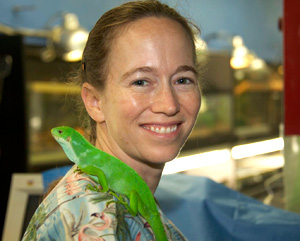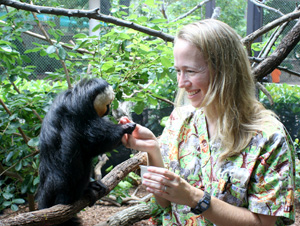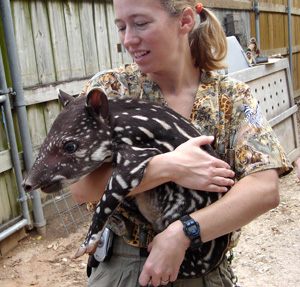Lauren Howard (DVM '00) — Every Day at Work is a Real “Zoo”
profile by Michael Sutphin
September 30, 2013

Even when she was a veterinary student, Dr. Lauren Howard knew that she wanted to provide care for animals both big and small after graduation. Today, the Class of 2000 graduate from the Virginia-Maryland College of Veterinary Medicine does just that as an associate veterinarian at the Houston Zoo.
Howard treats a range of species, from an endangered toad population in the greater Houston area to the zoo’s Asian elephants.
“I am one of four full-time veterinarians at the Houston Zoo,” explained Howard, who received the college’s Outstanding Alumna Award in 2010. “We provide care for all of the species at the zoo — mammals, reptiles, birds, and sometimes even invertebrates.”
After her four years at the veterinary school and a one-year rotating internship in small animal medicine and surgery at Oradell Animal Hospital in New Jersey, Howard scored a zoo medicine residency through a joint program of the University of California at Davis and the San Diego Zoo and Safari Park. “At the time, finding a residency was the ‘bottleneck’ for becoming a zoo veterinarian,” she said. “When I was applying, there were only about eight residencies in the country. It was a highly competitive process, but once you got into a residency, you were on track to find a job as a zoo vet.”
Howard began her current position at the Houston Zoo in 2005 — the same year she became a Diplomate of the American College of Zoological Medicine. She works with more than 100 animal care staff members to ensure that the zoo’s 5,000 animals there have the best medical care possible.

In addition to her day-to-day responsibilities, Howard is searching for new ways to fight a virus that has killed six young elephants at the zoo in the last 25 years: elephant endotheliotropic herpesvirus (EEHV).
“When you look at the numbers, it’s the single leading cause of death in Asian elephants born in the U.S. since 1978,” she said. “We have been able to attribute more than half of all deaths of Asian elephants under 35 years of age in the country to this virus.”
Howard grew up outside of Washington, D.C. and, as a high school student, visited Kumari, a baby elephant at the Washington National Zoo whose death brought national attention to the virus which can cause hemorrhagic disease and death in young elephants. It affects not only the North American and European Asian elephant population but also Asian elephants in the wild.
Recently, the Houston Zoo received a $459,000 field grant from the Institute of Museum and Library Services to fund the zoo’s research program in partnership with the Baylor College of Medicine, the Johns Hopkins University, and the National Elephant Herpesvirus Laboratory at the Smithsonian’s National Zoological Park.
“We are working to create better treatment recommendations and better understand the elephant’s immune response to EEHV with the ultimate goal of creating a vaccine,” Howard said. “This grant is the first major source of funding to study EEHV and puts us in a much more stable place to better understand the virus and develop a future vaccine that could decrease the severity of the virus.”
Howard jokes with friends and family that her pet projects at the Houston Zoo don’t make for polite dinnertime conversation. When she is not trying to protect Houston’s elephant population from herpes, Howard is trying to save its toad population from chlamydia.

“An endangered species of toad was discovered in Houston in 1950, and by 1960, it had already been moved out of the Houston area and relegated to pine forests outside of the city,” she explain. “Today, there are about 300 of these toads in the wild.”
Howard and others collect eggs, perform hormone-assisted captive propagation, and re-release eggs, tadpoles, and toads into the wild in partnership with the U.S. Fish and Wildlife Service.
None of these experiences would have been possible without the long hours of study that Howard logged at the veterinary school. She recalls fond memories of Dr. Bonnie Smith’s anatomy labs, Dr. Larry Freeman’s lectures on taxonomy and evolution, and Dr. Otto Lanz’s surgery rotations.
During her professional training, Howard also met her classmate and husband, Dr. Doug Humphrey, who is now as associate veterinarian at the Beechnut Animal Hospital in Houston. Together, they have two children: Annabelle, 6, and Tyler, 4.
Howard has some advice for anyone who wants to pursue her chosen career path. Although the number of residencies in zoo medicine have doubled since she first entered the profession, the number of job openings has not increased.
“While it’s definitely possible to become a zoo vet, you have to make sacrifices to do it,” she said. “You need to demonstrate interest in the field early in your veterinary training and make your own opportunities that will lead down the path of zoo medicine.”
Most important, however, is understanding the fundamentals of veterinary medicine. “First you have to be a good vet,” she said. “Then you can be a specialist.”
In her work at the Houston Zoo, Howard has certainly proven her abilities as both.


